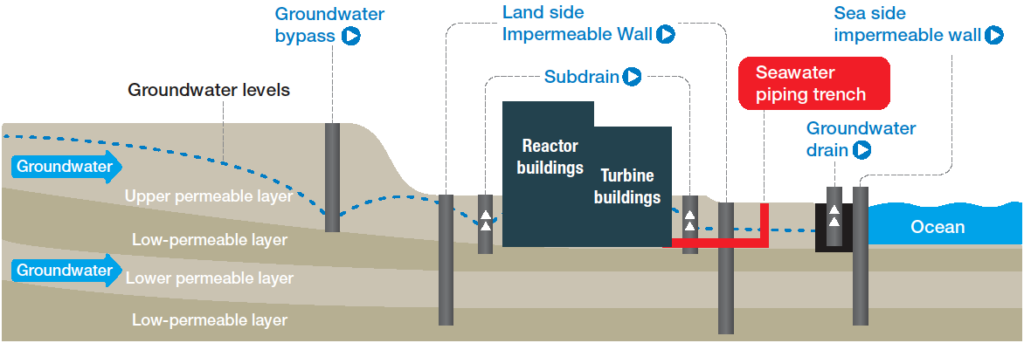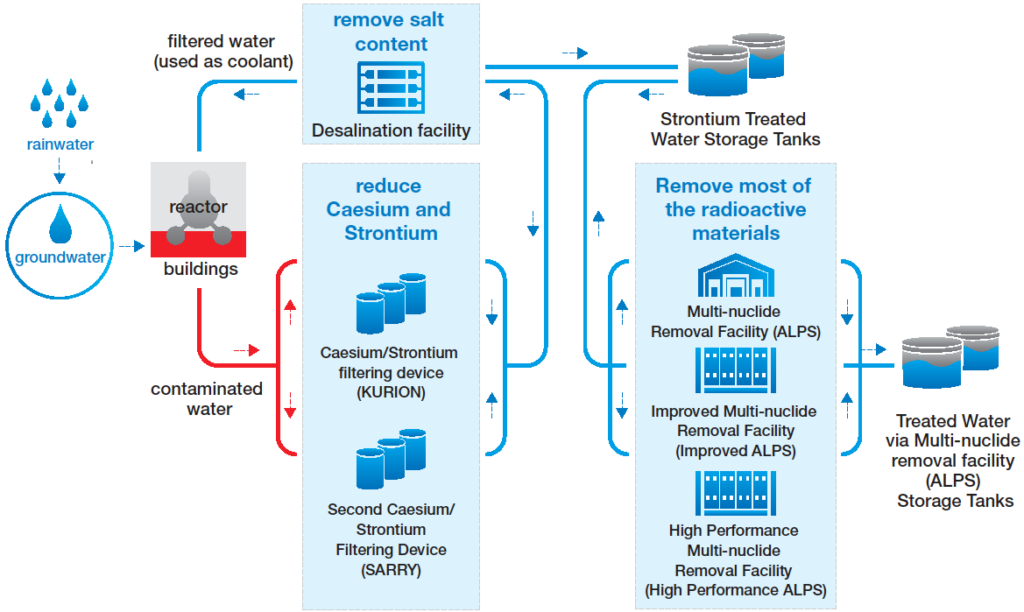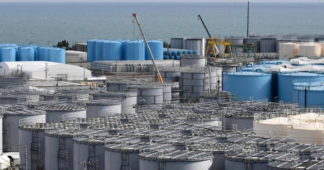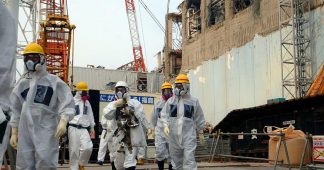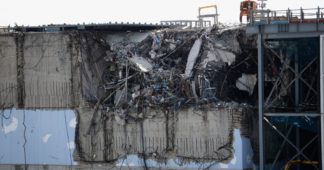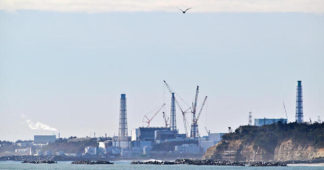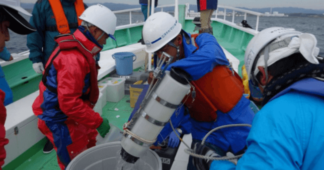By Tatsujiro Suzuki
September 22, 2023
On August 24, 2023, Japanese electric utility holding company Tokyo Electric Power Co. (TEPCO) announced that it has started discharging so-called “treated” and “diluted” water from the damaged Fukushima Daiichi nuclear power plant into the Pacific Ocean. This is not the end of controversy over the release of “treated water.” Rather, it may be the beginning of what might be a long-lasting struggle where science meets politics and lack of public trust, both inside and outside of Japan.
To understand TEPCO’s decision and why this operation caused such a big controversy, one must explain what this “treated water” being released is, the scientific debates over this operation, and the underlying social and political issues.
“Treated” or “contaminated” water? When underground water, including rainfall, passes through the damaged Fukushima Daiichi reactor site and is used to cool the melted fuel debris inside the reactors, it becomes contaminated with oil as well as many harmful radioactive nuclides, including cesium and strontium. Generation of “contaminated water” has been gradually declining due to various measures, such as pumping up water by sub-drains and the construction of impermeable, land-side frozen walls (see Figure 1). According to TEPCO, contaminated water generation declined from 540 cubic meters (m3) per day in 2014 to 90 m3 per day in 2022.
Part of the radioactive substances that contaminate the water is now being removed by multi-nuclide removal equipment called “advanced liquid processing systems” (ALPS)—an unfortunate name given that the Alps mountain range in Europe is home to some of the cleanest freshwater in the world. After the removal of most radioactive substances—except for tritium, which cannot be removed by the ALPS system—treated water is then stored in tanks (see Figure 2). The ALPS process is supposed to reduce the concentration of radionuclides, except tritium, to levels below regulatory standards. However, according to TEPCO’s data, as of March 31, 2023, of the total of about 1.3 million m3 of treated water, only about a third satisfied regulatory standards and the other two-thirds needed to be re-purified.
It can’t be denied that “treated water” is not as pure as “tritiated water” because treated water may still contain other radioactive nuclides, albeit in small proportions. But the comparison of Fukushima’s “treated water” with other “tritiated water” released during the normal operation of other nuclear power plants can be misleading because the latter is not contaminated with other radioactive nuclides.
TEPCO says it re-purifies the “treated water” to make sure the water satisfies regulatory standards before it is released to the sea. To do that, the company’s plan is to dilute “treated water” with large amounts of sea water to reach a concentration of tritium of 190 Becquerel (Bq) per liter, which is much lower than the allowed concentration of 1,500 Bq per liter.
The first discharge happened over a period of 17 days and involved a total of 7,800 tons of treated water being released to the sea. TEPCO plans to discharge treated water three more times in 2023, and the total tritium discharge by the end of March 2024 is expected to reach about 5 trillion Bq. This is much lower than the annual discharge target of 22 trillion Bq set before the Fukushima accident.
In addition to tritium, TEPCO must report that the concentration of all other radionuclides is below regulatory standards. To do this, TEPCO uses a simplified index, which corresponds to the sum of ratios of the concentration of each radioactive nuclides (excluding tritium) compared to regulatory standards. If this ratio is below one, it means the concentration of other radionuclides is below regulatory standards. TEPCO reported that the water being discharged during the first period was measured to have an index of 0.28, therefore satisfying regulatory standards. TEPCO said the operation may last at least 30 years to discharge all “treated water.”
Scientific debate. The Japanese government and TEPCO argue that the whole operation satisfies both Japanese regulatory standards and international safety standards. Besides, the Japanese government officially asked the International Atomic Energy Agency (IAEA) to conduct an independent review of the safety of the ALPS treated water release. On July 4, 2023, the IAEA published its “comprehensive report,” which concluded that the ALPS process is “consistent with relevant international safety standards” and that “the discharge of the treated water [into the sea], as currently planned by Tepco, will have a negligible radiological impact on people and the environment.”
But there are scientific arguments against TEPCO’s release plan.
The Pacific Island Forum expressed its concern in a statement in January 2023 about whether current international standards are adequate to handle the unprecedented case of the Fukushima Daiichi tritiated water release. Based on a report from an independent expert panel established by the forum, TEPCO’s guideline compliance plan does not appear to include the transboundary implications of IAEA’s guidance in its General Safety Guide No. 8 (GSG-8), which requires that the benefits of a given process outweigh the harms for individuals and societies.
The experts also recommended the alternative method of using the treated water to manufacture concrete for the construction industry instead of releasing it to the sea. By immobilizing the radionuclides in a material, this alternative would imply a lower potential for human contact and would avoid transboundary impacts. Quoted in a National Geographic article, one of the panel members, Robert Richmond, director of the Kewalo Marine Laboratory of the University of Hawaii, summarizes well the uncertainty surrounding the impacts of TEPCO’s water release plan on the ocean environment: “It is a trans-boundary and trans-generational event” and that he does not believe “the release would irreparably destroy the Pacific Ocean but it does not mean we should not be concerned.”
Lack of public trust. In addition to scientific debate, TEPCO’s ALPS treated water issue has become more of a social and political controversy. The origin of this debate was the speech given by then-Prime Minister Shinzo Abe before the International Olympic Committee on September 7, 2013, in which he referred to the city where the 2020 Summer Olympics were to be held by saying: “Some may have concerns about Fukushima. Let me assure you, the situation is under control. It has never done and will never do any damage to Tokyo.” After Abe’s speech, the government took over the responsibility for the management of the contaminated water, while TEPCO is still responsible for all decommissioning operations at the Fukushima Daiichi nuclear power plant. Since then, all policy decisions about the treated water have been made by the Japanese government, with TEPCO simply following the government, which has complicated the decision-making process.
In August 2015, the Japanese government and TEPCO promised to the local fishermen that they “will not implement any disposal without understanding of interested parties.” The government even established a committee consisting of experts from a local university to discuss technical options and held meetings with local citizens for several years to build trust with the local communities. So, when the decision was made by former Prime Minister Yoshihide Suga in August 2021 to release the “treated water” to the sea, this felt like a treachery for the local fishermen and many other interested parties. In a June 2023 statement opposing the planned discharge of treated water, the head of Japan’s national fisheries cooperatives Masanobu Sakamoto said: “We cannot support the government’s stance that an ocean release is the only solution. … Whether to release the water into the sea or not is a government decision, and in that case we want the government to fully take responsibility.”
The subsequent lack of public trust in TEPCO and Japan’s Ministry of Economy, Trade and Industry has been one of the major reasons for this continued controversy. In August 2018, a news investigation revealed that the “tritiated water” still contained other radioactive nuclides after treatment, which were above regulatory standards—a result that was not consistent with the explanation given by TEPCO. The justification then advanced by the ministry and TEPCO on the need and timing for the water discharge was no more convincing: They claimed that there would be a need for storage space once the melted fuel debris would be taken out of the reactors and that, without discharge now, the plant’s storage area would be filled soon. But, the timing—and even the feasibility—of removing the fuel debris is not known at all. Besides, there are potential storage space available at the nearby Fukushima Daini nuclear power plant.
Concerns have also spread to neighboring countries despite the Japanese government’s efforts to explain its plan. For instance, the South Korean government even sent some of its experts, including senior officials of the South Korean Nuclear Safety and Security Commission. Seemingly reassured after the visit, Yoo Guk-hee, the chairperson of South Korean commission, declared: “[I]f the water release is carried out as planned, the discharge standard and target level (of radiation) would be consistent with international standards”. Still, both fishermen and consumers in South Korea are worried about the impacts of water release from the Fukushima nuclear plant, which led the largest fisheries market to start monitoring the fish’s radioactivity to allay those concerns.
Building upon the South Korean experts’ visit, the Japanese government called for a science-based dialogue with the Chinese government, complaining that it continued to describe the Fukushima treated water as “contaminated” water. But the Japanese government’s effort seems not to have been successful, with a spokesperson of the Chinese Foreign Ministry saying that Japan has yet to prove that its planned water discharge is safe and harmless. In August, China decided to ban imports of all seafood products from Japan shortly after Japan started discharging treated water from Fukushima that month. And there seems to be no prospect of reducing tensions between the two countries over this issue.
How to improve the situation? Several options exist that could help restore public trust in TEPCO’s and the Japanese government’s treated water plan at Fukushima.
First, the Japanese government and TEPCO should realize that the management of radioactive wastewater is not a purely scientific and technical issue. Public controversies of this sort cannot be resolved by “science-based” dialogues only. Yes, a scientific dialogue is essential, but it’s not enough. Rather, Fukushima’s treated water is a typical case of “trans-science” using Alvin Weinberg’s term, meaning an issue where “questions which can be asked of science and yet which cannot be answered by science” (Weinberg’s emphasis). TEPCO’s and the Japanese government’s plan also needs a non-scientific approach to the issue and provide additional measures, including an improved decision-making process and a sincere dialogue (not persuasion) with stakeholders.
Second, to restore public trust and confidence, the government should first stop the water release and task an independent oversight organization which can be trusted by stakeholders. The IAEA review of TEPCO’s plan was helpful at best, but it was not enough, as it only verifies the samples provided by TEPCO for the first discharge but does not review the entire plan which could continue for the next 30 years. In fact, IAEA Director General Rafael Mariano Grossi clarified in the foreword of the agency’s “comprehensive report” that the review was “neither a recommendation nor an endorsement of that (government) policy.” Complete transparency over the entire decision-making process and disclosure of supporting data and information are essential conditions to improve public trust.
Third, TEPCO and the Japanese government should designate the current release operations as part of a “demonstration” program and declare that they will make a final decision about the plan after studies confirm that the release has had no significant impacts on the ocean environment and fish. This would imply that the government stops the release of the treated water, and asks the scientific community to conduct such studies. At the same time, the government could also continue to explore technical alternatives to its plan that may be more attractive to both domestic and international stakeholders. In addition to provide a face-saving opportunity to the Japanese government and TEPCO to justify that they “temporarily” halt the release, it would show that they have sincerely listened to the concerns expressed by the stakeholders.
The Japanese government and TEPCO clearly have the ability to improve public trust in their handling of the treated water at Fukushima, but this requires them to go beyond their “scientific logic” only.
We remind our readers that publication of articles on our site does not mean that we agree with what is written. Our policy is to publish anything which we consider of interest, so as to assist our readers in forming their opinions. Sometimes we even publish articles with which we totally disagree, since we believe it is important for our readers to be informed on as wide a spectrum of views as possible.
